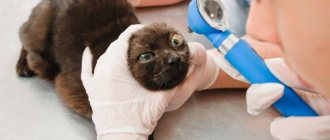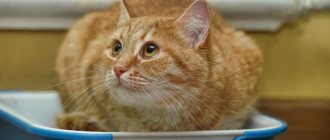Mycoplasmas are a blood parasitic infection. Mycoplasmas infect erythrocytes - red blood cells, which as a result leads to serious disruptions in the functioning of the immune system.
A cat owner must know how dangerous mycoplasma is, what negative effects can be expected for the body, and how to protect their pet from the development of pathology. Providing timely assistance to a cat with mycoplasmosis will help maintain the pet’s health and avoid the development of dangerous complications.
Description of the causative agent of mycoplasmosis
An infectious disease, of the contagious type, provokes changes in the functioning of various body systems. Mycoplasmosis leads to problems in the urinary and respiratory systems, provokes the development of conjunctivitis and inflammatory processes in the joints.
In some cases, a cat may be a carrier of mycoplasma, but will not show symptoms of the disease. In this regard, the diagnosis of mycoplasmosis is significantly complicated.
Blood cell problems are often associated with mycoplasmosis in cats. Pets are diagnosed with hemolytic anemia of the autoimmune type. Microscopic parasitic organisms actively infect red blood cells, causing a specific response from the immune system. As a result, this leads to the fact that the body's own protective cells perceive red blood cells as foreign and begin to attack them.
In veterinary medicine, only three types of mycoplasmas have been studied, most often diagnosed in domestic animals:
- M. haemofelis
- M. haemominutum
- M. turicensis
Mycoplasma haemofelis is the largest of the above-mentioned blood-parasitic microorganisms and in the vast majority of cases causes pathological processes in the body of domestic cats. The risk group for the development of mycoplasmosis includes cats with weak immune defenses - young and elderly animals, as well as those that are under stress or have suffered serious illnesses.
The connection between the development of mycoplasmosis in cats with the presence of viral immunodeficiency and viral leukemia in cats has also been proven. The true route of transmission of mycoplasmosis could not be identified, but the cat flea is believed to be a potential link.
Mycoplasmosis can be transmitted from a sick animal to a healthy one through close contact (for example, sexual intercourse or a fight). Fights with relatives, accompanied by serious bites until they bleed, scratches and other injuries.
Presumably, mycoplasmosis can be transmitted to infected cats that are bearing offspring. When passing through the birth canal, babies become infected with mycoplasmosis and may even die, since their immune system is weakened.
Ways of helminths entering the body
There are several of them, but the most common ways are four:
- From person or animal to person. This is how, for example, pinworm infection occurs. If a person infected with this type of worms touches various objects without washing their hands, then this will become a risk factor for others (it is not without reason that enterobiasis - and this is what pinworm infection is called - is an occupational disease of teachers, because pinworms are a real scourge of primary schoolchildren) .
- Through the soil. Worm eggs enter it along with human and animal feces, after which they are carried by water, insects, pets or wind (with dust particles) and end up on food or directly into the digestive tract or respiratory tract.
- When eating food that has not been subjected to heat treatment. Raw or half-raw meat or fish infected with worms are very dangerous. Therefore, you should very carefully choose restaurants that serve sushi.
- For insect bites. This happens quite rarely, but the risk of contracting helminthiasis through a bite increases when traveling to exotic countries.
How does a cat become infected with mycoplasmosis?
The main ways of infecting a pet with mycoplasmosis are:
- airborne;
- straight on contact;
- sexual;
- from mother to kittens (when babies pass through the birth canal).
Mycoplasmas are able to reproduce under favorable environmental conditions. Parasitic microorganisms grow at temperatures from 18 to 42 degrees. The optimal temperature indicators for the growth of pathogens in the body of animals or humans are from 37 to 38 degrees. In this regard, the cat’s body is a favorable capsule for the development of mycoplasma.
At room temperature, microorganisms can remain active for 90 days, but when the temperature rises to 60 degrees, viability remains for about 10 minutes. When the surface is treated with ultraviolet light or when exposed to direct sunlight, mycoplasmas die after 3 hours.
The peculiarity of mycoplasmas is that they are not bacteria in the standard sense of this meaning. In this regard, mycoplasmas have a certain resistance to the effects of most antibiotics. Sulfonamides are also useless against mycoplasmas.
Mycoplasmas die when their shell is exposed to disinfectants and furan compounds.
Helminthiasis - a childhood disease?
Worms are often considered a childhood disease. The reason for this is that children often do not follow the simplest hygiene requirements: they do not wash their hands when coming from the street, after visiting the toilet or petting an animal, they eat dirty fruits and vegetables, and they may drink unboiled water. Kids, in addition, get to know the world by testing it by taste - they, as you know, put everything they can reach into their mouths. This is how parasite eggs enter the body.
The facts today are as follows: yes, children suffer from helminthiasis more often than adults. But this does not mean that advanced age is insurance against the penetration of worms into the body.
Danger of infection for humans
There is a danger of infection for humans, especially for those categories that have a weakened immune system. This includes small children under 3 years old, as well as:
- people with immunodeficiency virus;
- patients with chronic pathologies;
- those forced to undergo chemotherapy, as well as those who have recently undergone surgery.
It is worth noting that the likelihood of contracting mycoplasmosis directly from a domestic cat is much less than the strain that affects humans. But for the purpose of prevention, veterinarians recommend not to interfere or have close contact with domestic cats that have been diagnosed with mycoplasmosis. It is also not advisable to hand feed a sick animal until it has fully recovered.
In order to prevent infection with mycoplasmosis, it is necessary to thoroughly and regularly wash your hands with soap and treat with antiseptic agents.
Symptoms of mycoplasmosis in cats
Depending on what type of mycoplasma the domestic cat has, the state of immunity and the age of the animal, the symptoms will vary. The main signs of mycoplasmosis in cats are:
- Inflammation of the conjunctival membrane. Mycoplasmosis is most often characterized by hyperemia of the mucous membranes of the eyes and specific discharge. Damage to the corneal layer is less commonly diagnosed.
- Inflammatory processes in the respiratory tract. An animal with mycoplasmosis may suffer from a severe cough, discharge from the nasal passages, and fever. The disease can become chronic.
- Infectious lesions of the urinary and reproductive systems. Penetrating into the genital tract and urinary tract, mycoplasmas provoke the development of inflammation in the bladder, urethra, as well as endometritis and vaginitis. Characteristic signs of infection caused by mycoplasmosis are pain during urination, the inability to bear kittens, and discharge from the area of the cat's prepuce or loop. It is also possible for kittens to become infected inside the womb and for non-viable babies to be born.
- Diseases of internal organs. Animals with a weakened immune system are unable to resist mycoplasmosis. Pathogens enter the bloodstream through the mucous membranes, provoking inflammatory processes in the structures of the liver, kidneys, spleen and lungs.
- Infectious lesions of skeletal muscles. Inflammation occurs in the joints. Often with mycoplasmosis, polyarthritis develops, up to the appearance of lameness, feverish states, stiffness in movements, and general malaise. Multiple abscesses are diagnosed.
An asymptomatic course of mycoplasmosis is also possible. In such cases, the animal is a carrier of the infection, infecting animals near it through close contact.
Diagnosis of mycoplasmosis
The insidiousness of mycoplasmosis lies in the fact that pathogens are sometimes part of the normal opportunistic microflora. During normal functioning of the immune system, pathogens do not show their activity. As soon as the protective forces are reduced, mycoplasmas begin to actively develop, causing a number of pathological changes.
Making an accurate diagnosis is not possible without visiting a veterinarian. During an examination by a specialist, a number of laboratory tests are carried out, which must be carried out for an accurate diagnosis. It is recommended to:
- biochemical blood test;
- general blood test and for the presence of specific antibodies;
- general urine analysis.
Diagnostics includes a number of advanced techniques in the event that mycoplasmosis is in an advanced stage and has led to damage to internal organs. Thus, if inflammation of the genital organs and urinary tract by mycoplasmas is suspected, tests of specific prostate secretions are prescribed. For polyarthritis, synovial fluid samples are taken. In case of damage to the pulmonary structures, a study is performed - bronchoalveolar lavage.
Ureaplasma and pregnancy
Despite numerous debates about the influence of ureaplasma on the course and outcome of pregnancy, there is still no consensus on the treatment tactics for this group of women. Previously, this microorganism was “blamed” for premature birth and spontaneous miscarriages. Research to date has refuted the above. For example, experts from the US Centers for Disease Control and Prevention (CDC, 2010) do not consider the etiological role and clinical significance of ureaplasma to be proven. When ureaplasma is combined with other infectious pathogens (chlamydia, trichomonas, gonorrhea, mycoplasma), antibacterial treatment is necessary! And it must be carried out taking into account the sensitivity of the above microorganisms to antibacterial drugs. Routine screening of pregnant women for ureaplasma is not carried out.
In conclusion, I want to say that there is no need to be afraid of ureaplasma. Remember, your gynecologist should carry out treatment only taking into account the entire clinical picture, and not on the basis of routine tests.
The material was prepared by Kuzina Anastasia Vadimovna, obstetrician-gynecologist, ultrasound diagnostics doctor.
To make an appointment with a gynecologist, call the single contact center in Moscow, use the online appointment service, or contact the clinic reception.
Treatment of mycoplasmosis in cats
Based on the tests obtained, the veterinarian can formulate the main stages of treatment. In-depth diagnostics may also include blood tests to identify other possible pathogens, since mycoplasmosis often occurs against the background of another disease. Treatment of mycoplasmosis in cats is not simple, as it is necessary to select an individual regimen. The following complexes are used:
- antibiotics – Doxycyline, Tetracycline;
- general strengthening drugs - Gamavit, Katazal;
- immunomodulatory agents – Transfer Factor and Immunofan;
- hepatoprotectors – Karsil;
- anti-inflammatory drugs - Dexavet.
Eye wash preparations based on medicinal plants and disinfectant solutions are also prescribed.
What to feed a cat diagnosed with mycoplasmosis
The nutrition of an animal suffering from mycoplasmosis must be rational. If your pet is used to receiving natural food, it is recommended to consult a veterinarian about vitamin and mineral supplements to the diet. Food should be easily digestible, but at the same time replenish all the body’s energy reserves.
It is best to give your pet canned food and ready-made granulated food used for liver pathologies during treatment of mycoplasmosis and for the first time after complete recovery.
The food should also be hypoallergenic, since the processes occurring in the body during mycoplasmosis negatively affect the immune system. Treatment of mycoplasmosis is long-term – from 3 weeks to several months (in the chronic form of the pathology). Therefore, the owner’s task is to create all the conditions for successful treatment.
How dangerous are worms?
A reasonable question: if the worms will most likely disappear on their own after some time, is it worth treating them? Doctors answer: this step is necessary.
Some types of worms have a very long lifespan and during this time they will have time to harm our health. But even parasites such as pinworms, which die after about a month, are harmful to the body.
Possible consequences of infection:
- The waste products of worms act on the human body as poisons or allergens, reducing overall well-being. An allergic reaction, in turn, can lead to Quincke's edema and death.
- Living in human tissues and organs, helminths damage them mechanically and interfere with normal functioning.
- Worm larvae, migrating throughout the body in the bloodstream or entering the respiratory tract, can clog blood vessels and cause bronchial obstruction.
- Some types of helminths disrupt the digestive process, which can lead to severe poisoning.
- Experts have discovered that there are helminths that cause cancer.
Worms are the most dangerous for children: in addition to a huge range of diseases and decreased immunity, they can cause developmental delays, both physical and mental.
Can a cat that has had mycoplasmosis get it again?
This possibility exists. This can also happen due to violations of the content rules. Mycoplasmas can be found on surfaces and animal care items. Therefore, when treating a cat for diagnosed mycoplasmosis, it is very important to isolate the pet from other animals. Also important:
- Keep the room clean by regularly changing the bedding on which the cat sleeps.
- Provide free access to clean drinking water. If the cat is so weakened that it cannot rise on its own, it is necessary to give the pet water from a syringe without a needle or from a pipette.
- Limit contact with human hands. The point here is not only about the risk of infection of the owner himself. A sick animal may suffer from discomfort and pain, so at the time of treatment, it is better to limit lifting the animal in your arms.
- Observe any changes in the animal's condition. The slightest deterioration in health requires immediate contact with a veterinary hospital.
Prevention
Mycoplasmosis in animals does not have medications to prevent the disease. Cats are not vaccinated against it.
Owners should pay special attention to pets walking outside. While outdoors, a cat can become infected from other types of animals.
The best preventative measures for pets are proper care and nutrition, deworming and treatment for parasites, timely vaccinations and periodic examinations of the pet by a veterinarian.
After sterilization, it is recommended to carefully monitor the healing process and in case of suppuration, immediately consult a doctor.
If animals live in nurseries or shelters, the premises where they are kept are disinfested and kept clean. An animal suspected of having mycoplasmosis is removed from healthy animals until complete recovery.











